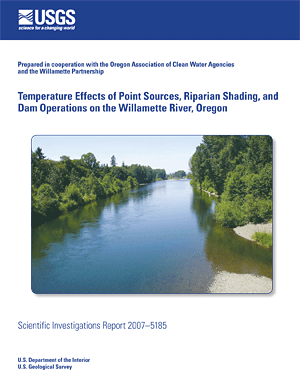Scientific Investigations Report 2007–5185
U.S. GEOLOGICAL SURVEY
Scientific Investigations Report 2007–5185
Temperature Effects of Point Sources, Riparian Shading, and Dam Operations on the Willamette River, Oregon
Prepared in cooperation with the Oregon Association of Clean Water Agencies and the Willamette Partnership
By Stewart A. Rounds

Table of Contents
Conversion Factors, Datums, and Acronyms and Abbreviations
Abstract
Introduction
Description of Models
Methods
Temperature Effects of Point Sources
Temperature Effects of Riparian Shading
Temperature Effects of Dam Operations
Summary and Conclusions
Acknowledgments
Supplemental Material
References Cited
Appendix A. CE‑QUAL‑W2 Code Changes
Figures
Figure 1. Location of the river network, the modeled river reaches, and major reservoirs in the Willamette River basin, Oregon.
Figure 2. Comparison of the sum of the individual point-source heating signatures to the results from one model run containing all point sources.
Figure 3. Percentiles from two hypothetical normal distributions, A and B, as well as two distributions resulting from the addition of A and B.
Figure 4. Results of hypothetical heat-trading test case 1, showing 7dADM point-source temperature effects from the test case’s model run and errors associated with the Trading Tool estimate.
Figure 5. Results of hypothetical heat-trading test case 2, showing 7dADM point-source temperature effects from the test case’s model run and errors associated with the Trading Tool estimate.
Figure 6. Results of hypothetical heat-trading test case 3, showing 7dADM point-source temperature effects from the test case’s model run and errors associated with the Trading Tool estimate.
Figure 7. Results of hypothetical heat-trading test case 4, showing 7dADM point-source temperature effects from the test case’s model run and errors associated with the Trading Tool estimate.
Figure 8. Thermal effects of restoring riparian vegetation along the Long Tom River, as manifested by a water-temperature change in the Willamette River.
Figure 9. Modeled temperature changes associated with shade restoration along selected 5-mile reaches of the upper Willamette River, from river mile 116.87 near Albany to river mile 176.80 just upstream of the McKenzie River confluence.
Figure 10. Aerial view of Cougar Dam and Reservoir, looking south.
Figure 11. Seasonal water temperature patterns in the South Fork McKenzie River upstream and downstream of Cougar Reservoir, prior to the construction of a selective withdrawal tower at Cougar Dam, Oregon, 2001.
Figure 12. Seasonal water temperature patterns in the South Fork McKenzie River downstream of Cougar Dam in 2001, 2002, and 2006.
Figure 13. Modeled changes in the 7-day moving average of the daily maximum water-temperature difference in the South Fork McKenzie and McKenzie Rivers in response to the construction of a selective withdrawal tower at Cougar Dam, Oregon.
Figure 14. Modeled changes in the 7-day moving average of the daily maximum water-temperature difference in the South Fork McKenzie, McKenzie, and Willamette Rivers in response to the construction of a selective withdrawal tower at Cougar Dam, Oregon.
Figure 15. Effects of the Cougar Dam selective withdrawal tower on the cumulative heating effects of the modeled point sources.
Tables
Table 1. Point sources of heat included in the Willamette River flow and temperature models.
Table 2. Locations of tributaries included in the Willamette River flow and temperature models that discharge to the Willamette or Coast Fork Willamette Rivers.
Table 3. Prediction errors of the Trading Tool when used to estimate the effects of several hypothetical heat-trading test cases.
Table 4. Cooling effects of several shading scenarios on the Willamette River, Oregon.
This report is available online in Portable Document Format (PDF). If you do not
have the Adobe
Acrobat PDF Reader, it is available for free download from Adobe Systems Incorporated.
Document Accessibility:
Adobe Systems Incorporated has information about PDFs and the visually impaired.
This information provides tools to help make PDF files accessible. These tools
convert Adobe PDF documents into HTML or ASCII text, which then can be read
by a number of common screen-reading programs that synthesize text as audible
speech. In addition, an accessible version of Adobe Reader 8.0 for Windows
(English only), which contains support for screen readers, is available. These
tools and the accessible reader may be obtained free from Adobe at Adobe Access.
Send questions or comments about this report to the author, S. A. Rounds, (503) 251-3280.
For more information about USGS activities in Oregon, visit the USGS Oregon Water Science Center home page.
